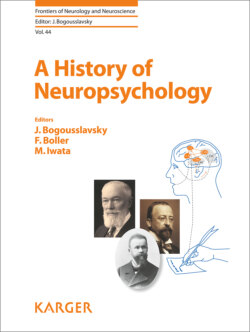Читать книгу A History of Neuropsychology - Группа авторов - Страница 12
На сайте Литреса книга снята с продажи.
Gall’s Localization Theory
ОглавлениеThe stage was set in the early 1800s by Franz Joseph Gall (Fig. 1). In his localization theory, or organology, he proposed that the mind has 27 discrete, self-contained faculties, or modules, in two categories: Intellectual, ranging from speech, memory of words, and music, to sense of place, space, and persons, and Moral, encompassing passions and feelings, such as courage and love of family; that each faculty has a corresponding organ and location in the brain; that the organs come in pairs, one in the left hemisphere, one in the right; that their size reflects faculty strength; and that strengths and weaknesses appear as enlargements and depressions on the brain’s surface and overlying skull, allowing their measurement by inspection ([1], p 71 ff.).
Fig. 1. Franz Joseph Gall (1758–1828). Oxford Science Archive / Heritage image. Reprinted with kind permission.
To map the brain, Gall examined heads of living persons along with skulls, plaster casts, and portraits, focusing on persons at the extremes. For example, he located the speech organ in the anterior half of the supra-orbital frontal gyri after finding an enlargement there in orators and writers and a depression in a lunatic unable to speak; for music, he looked for similarly differentiating features in persons with and without musical ability, the former including musicians, composers, and a 5-year-old child who could remember “whole concerts” heard “at most twice” ([2], p 63). Gall also studied persons with “accidental (brain) mutilations.” In one, a soldier injured by a fencing foil that penetrated just below his left eye into the site of the speech organ, “nothing is lost … but the faculty of speaking” ([2], p 23). Organology, or phrenology, the name favored by Gall’s associate, Johann Spurzheim, won both praise and scorn, the latter mostly from scientists (anatomists and physiologists), who criticized it for overstatements, reliance on anecdote and uncontrolled clinical reports, and for proposing that the organs could be measured by inspection when, as the anatomist Sewall [3] stated in 1837, “the frontal sinuses and temporal muscles alone” put the majority “beyond the reach of observation” (p 51). Gall’s most resolute critic, Pierre Flourens [4], claimed from animal experiments that the faculties are co-extensive, not discrete, and that the brain and mind function wholistically. In 1838, François Magendie [5] summed it up: phrenology was “a pseudo-science of the present day” (p 150).
It endured nonetheless. Supporters liked its simplicity, grandness of scale (ever grander as the list of faculties grew), and promise of understanding the self (for which many were eager to pay) – in 1911, Bierce [6] called phrenology “picking the pocket through the scalp” (p 98). Most importantly, some physicians, prominently Bouillaud [7], believed that Gall was right at least about speech: they too had seen persons made speechless from stroke or “accidental mutilations” of the anterior lobes.
